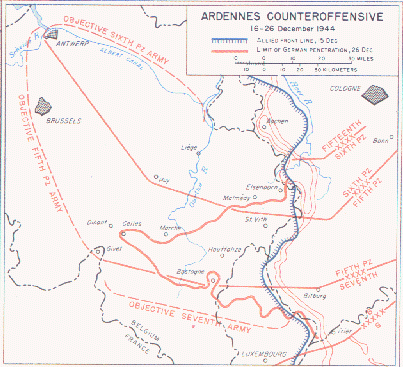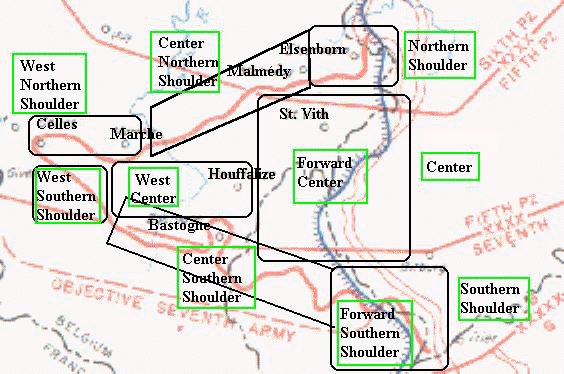

|
Welcome to Wesley Johnston's (somewhat reluctant) Battle of the Bulge (Ardennes Offensive) web page, part of the 7th Armored Division web site. For now, this is primarily a link page, a focal point for Battle of the Bulge (Ardennes Offensive) information on the web. And it is a work in progress. So if you see something missing, please let me know. This page has these sections:
|
|
Note: Since all the mentions of this army and that army can become confusing, German units are given in italics, and American units are in normal type.
The Battle of the Bulge began with the German attack (Operation Wacht am Rhein and the Herbstnebel plan) on the morning of December 16, 1944. Two later attacks on New Year's Day 1945 attempted to create second fronts in Holland (Operation Schneeman) and in northern France (Operation Nordwind).
The overall German plan is laid out in the map above (from Hugh Cole's official history "The Ardennes: Battle of the Bulge", Map IX). In the original plan, three Armies (the Sixth Panzer Army [referred to by Hitler as Sixth SS Panzer Army but not formally designated as SS at the time - Cole, p. 76], Fifth Panzer Army, and Seventh Army) would attack.
The terrain was the dense Ardennes Forest. The weather was chilly mist and fog, so that Allied air support was nullified until December 23. (In fact, one of the German plans was named Herbstnebel or Autumn Mist.) In addition, ground visibility for the troops was often very low, due to the trees and fog. The dense forest had very few roads, none of which were large. Traffic jams on both sides of the front were a major problem for both Armies.
The only railroad on the entire front to cross from Germany into Belgium came to St. Vith, Belgium, making St. Vith, which was also a major road junction. Thus St. Vith was the most vital initial prize the Germans sought, in order to allow supplies to flow to support the remainder of the attack. It was no accident that St. Vith was right in the very center of the Fifth and Sixth Panzer Armies: St. Vith had to be the main line of supply for both Armies. The German plan called for capture of St. Vith by 1800 on December 17 by Fifth Panzer Army, but the defenders held at St. Vith until late on December 21. This led the German Fifth Panzer Army Commander, Gen. Hasso von Manteuffel, to recommend to Hitler's adjutant on December 24 that "the German Army give up the attack and return to the West Wall." Manteuffel's reason for this recommendation was "due to the time lost by his Fifth Panzer Army in the St. Vith area." [Manteuffel press conference of 22 December 1964 in Watertown, NY]
Hitler did not accept Manteuffel's recommendation, and the German supplies began to run out. German columns ran low on gas and ammunition well before reaching even their first major goal: the Meuse River. On December 23, the weather cleared, and Allied planes finally filled the skies in support of the besieged American troops. (Some of the GI's had wondered why they saw German planes before that, despite the conditions, but saw no American planes.)
Slowly but surely the Allies -- from the North, the West, and the South -- closed the salient, the Bulge. The First US Army troops from the north met the Third US Army troops from the south at Houffalize, Belgium on January 16, 1945. St. Vith was recaptured on January 23, 1945. The ending date of the Bulge is considered as January 25, 1945, since this was the date on which the lost positions were officially thought to have been completely regained. In fact, as a series of letters in the VBOB "Bulge Bugle" have noted, some positions were not regained until after January 25, 1945.
In the largest battle ever fought by the U. S. Army, with 600,000 GI's involved, it is difficult to place one unit or location ahead of another in importance. But the reality is that two crucial stands at the front lines are what really doomed the German attack to certain failure:
It is significant to note that the 7th Armored Division was near Aachen, Germany when the German attack began. The 7th Armored Division had to move 60-70 miles to the south on Day 2. If the 99th Infantry Division and 291st Engineer Combat Battalion had not held on the northern shoulder, the 7th Armored Division never would have reached St. Vith. Even when the 7th Armored Division had reached St. Vith, it was the troops on the northern shoulder and the newly arrived 82nd Airborne Division that kept a very narrow escape route open for the virtually surrounded defenders of St. Vith. But once the defense of St. Vith was set up, that defense also bolstered the defense of the northern shoulder, as both defenses forced the German columns off of their planned routes and led to considerable congestion as the Gemran columns were then funneled in between the northern shoulder and the St. Vith salient.
But what about Bastogne? In popular thinking, the Battle of the Bulge is synonymous with the Battle of Bastogne. This is very unfortunate, since it ignores the real military keys (holding the northern shoulder and holding St. Vith) to the defeat of the Germans. Journalists hungry for some sign of American success at stopping the German onslaught played up the defense of Bastogne, where Gen. Anthony McAuliffe (101st Airborne Division) said "Nuts" to a German surrender demand and where the Third US Army (10th Armored Division) broke through the German Seventh Army's buffer to reach the surrounded town on Day 3 of the Battle of the Bulge. This was truly heroic stuff. But from a military strategy point of view (and this can easily be seen on the map above), while Bastogne was a strategically important major road junction for sustaining the attack, it was on the periphery of the attack and well behind the initial front lines. The German plan was to have the panzers bypass Bastogne and let the later echelons of infantry and artillery units clean it out. And the panzers did succeed in bypassing Bastogne, so that their plan in that sector was on schedule. As a source for rallying U. S. spirits, the defense of Bastogne and McAuliffe's "Nuts" were a success. But from a strategic perspective, the German fate had already been sealed at St. Vith, when they could not take that critical supply center on Day 2 - nor on Days 3, 4, 5, and most of 6. Bastogne did not become surrounded by forces intent on taking it until the night of December 21, Day 6 of the Battle of the Bulge. And the famous "Nuts" did not come until December 22, Day 7. Heroic as the deeds of the defenders of Bastogne were, the defense of Bastogne is a very important secondary element but not one of the true strategic keys to the German failure.
Since the battle was so complex, it is important to consider some basic organizing themes. Unfortunately, due to the complexity of the battle and to other circumstances, there are a great number of popular misconceptions about the Battle of the Bulge; so I hope to set some of these straight. |
|
This is not an Order of Battle. It is an attempt to give the units' locations in the major areas of the Battle of the Bulge (Ardennes Offensive), as well as links to their web pages, if they have a web page. Thus a unit may appear more than once, if it moved from one area to another. Units are listed at the highest level in which they participated. Usually this means Division level. So if your unit was part of a Division, look for that Division.
The links given here are to pages that provide solid links for someone to follow to gain in-depth information on these units' role in the Bulge, primarily for the purpose of finding a relative's story - e.g. reunions, veterans, primary source material, published histories. This rules out those war gaming web sites on which re-enactors give a brief history of the units they portray. But a few war gaming sites are of sufficient quality and historical depth about the unit's actual experiences to merit inclusion. Such war gaming sites are indicated by the unit name being in italics: e.g. 90th Infantry Division.
For all Divisions, you may also want to see their brief history in the Center for Military History's "Combat Chronicle" web pages.
Here is the layout of the geographic areas of the battlefield. This is NOT an interactive map. So click on one of the areas in the list below the map to go to a specific area.

Any unit anywhere in the Bulge or along the edge of the Bulge was in combat with German units. If they were in the forward part of the Bulge, the contact came sooner during the battle. If they were originally in the rear and western areas of the Bulge, the contact came later when what had been the rear became the front lines.
|
A note on Operation Schneeman: The only reference that I have found for this operation is on page 199 of "The Forgotten Battle: Overloon and the Maas Salient 1944-1945" the English translation of the original Dutch book by A. Korthals Altes and N. K. C. A. in't Veld (Sarpedon, 1995). The German press played it up as the "Wanssum Bridgehead" (Brückenkopf Wanssum) across the Maas at Wanssum, north of Venlo, Holland. It was apparently timed with Nordwind (in Alsace) on New Year's Day. It was closed out quickly with a counter-attack by "two companies from the Suffolks" on January 8, 1945.
There are many units that received recognition for participation in the Ardennes-Alsace campaign. This is a list of some of those units so recognized but for which I have yet to determine their geographic location during the Battle of the Bulge. If you have information on these, please let me know.
|
|